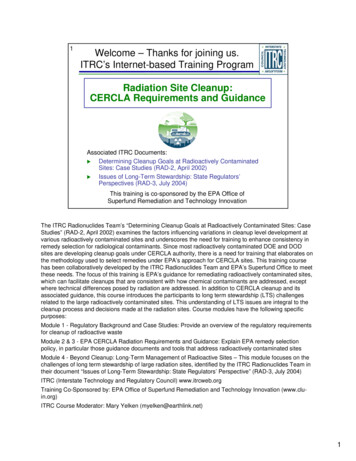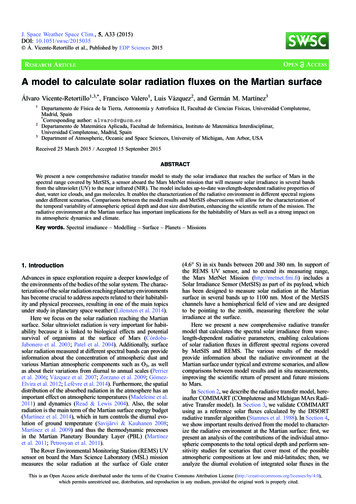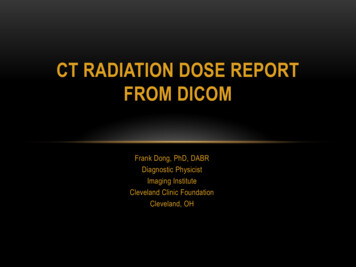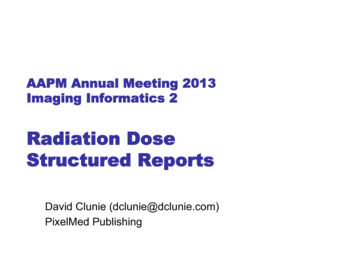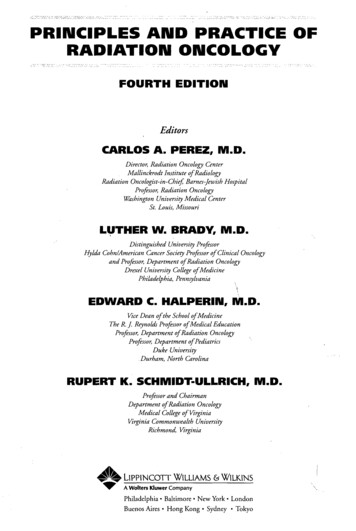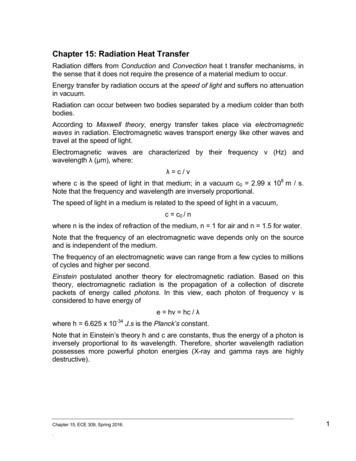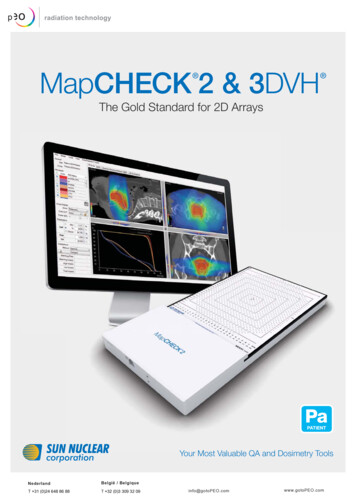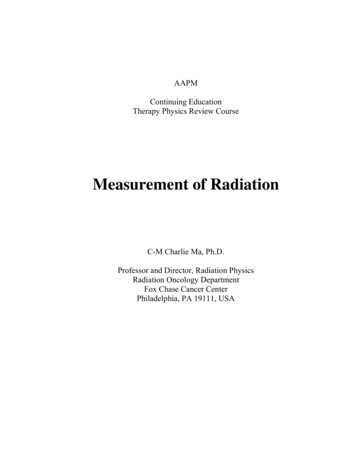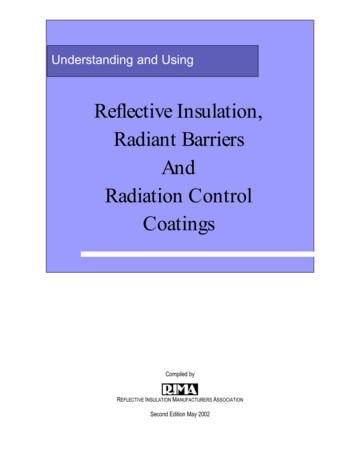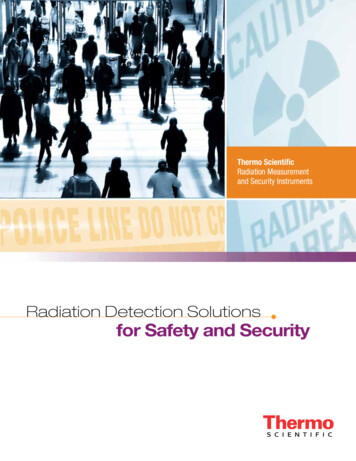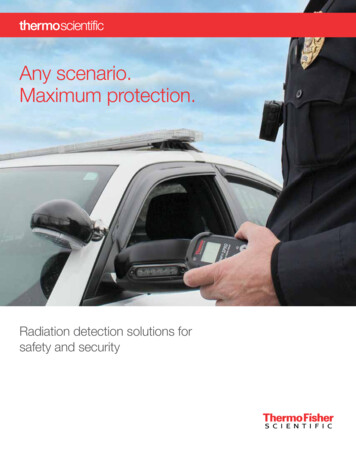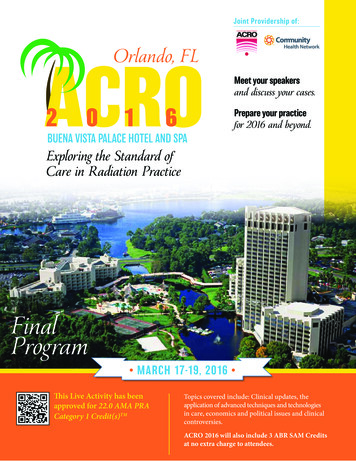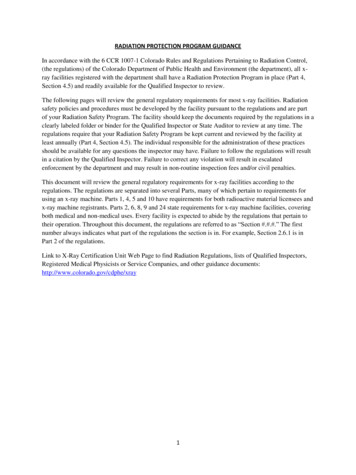
Transcription
RADIATION PROTECTION PROGRAM GUIDANCEIn accordance with the 6 CCR 1007-1 Colorado Rules and Regulations Pertaining to Radiation Control,(the regulations) of the Colorado Department of Public Health and Environment (the department), all xray facilities registered with the department shall have a Radiation Protection Program in place (Part 4,Section 4.5) and readily available for the Qualified Inspector to review.The following pages will review the general regulatory requirements for most x-ray facilities. Radiationsafety policies and procedures must be developed by the facility pursuant to the regulations and are partof your Radiation Safety Program. The facility should keep the documents required by the regulations in aclearly labeled folder or binder for the Qualified Inspector or State Auditor to review at any time. Theregulations require that your Radiation Safety Program be kept current and reviewed by the facility atleast annually (Part 4, Section 4.5). The individual responsible for the administration of these practicesshould be available for any questions the inspector may have. Failure to follow the regulations will resultin a citation by the Qualified Inspector. Failure to correct any violation will result in escalatedenforcement by the department and may result in non-routine inspection fees and/or civil penalties.This document will review the general regulatory requirements for x-ray facilities according to theregulations. The regulations are separated into several Parts, many of which pertain to requirements forusing an x-ray machine. Parts 1, 4, 5 and 10 have requirements for both radioactive material licensees andx-ray machine registrants. Parts 2, 6, 8, 9 and 24 state requirements for x-ray machine facilities, coveringboth medical and non-medical uses. Every facility is expected to abide by the regulations that pertain totheir operation. Throughout this document, the regulations are referred to as “Section #.#.#.” The firstnumber always indicates what part of the regulations the section is in. For example, Section 2.6.1 is inPart 2 of the regulations.Link to X-Ray Certification Unit Web Page to find Radiation Regulations, lists of Qualified Inspectors,Registered Medical Physicists or Service Companies, and other guidance documents:http://www.colorado.gov/cdphe/xray1
THE X-RAY CERTIFICATION UNITThe X-Ray Certification Unit (the unit) is part of the Radiation Control Program of the HazardousMaterial and Waste Management Division in the Colorado Department of Public Health and Environment(the department). The unit is responsible for writing regulations that ensure the safe use of radiationproducing machines (e.g. x-ray machines) and is also responsible for enforcing those regulations. TheRadiation Control Act (Title 25, Article 11 of the Colorado Revised Statutes) authorizes the department todevelop and enforce these regulations. Parts 2, 4, 6, 5, 8, 9, 10 and 24 pertain to radiation machineregulations.In general, the regulations require registration of all radiation machines and facilities where they are used,and regular evaluation of each machine and facility to ensure the safety of the workers and public fromradiation sources. Depending on the type of x-ray machine used, the machine must be evaluated annually,bi-annually or once every three years. These evaluations, or “routine inspections,” and are done byregistered, private individuals known as Qualified Inspectors (QI). Unit personnel listed below do notperform routine inspections.A list of the approximately 80 registered Qualified Inspectors in Colorado is available on our website.Qualified Inspectors may be limited to the type of x-ray machine they can evaluate, so it is important tochoose the correct QI for your facility. Mammography, CT, Fluoroscopic and Therapy systems must beinspected by Registered Medical Physicists. Two months before the x-ray machine is due for inspection,the unit will send courtesy notices (green postcards) to a facility’s address on file.The unit will send notices to the registrant of non-compliance issues, such as over-due inspections orwhen the facility misses a deadline to submit corrective actions. Failure to correct non-complianceswithin the designated time frame will result in escalated enforcement actions taken by the unit. If noresponse is received from the facility concerning violations, unit staff will perform non-routineinspections at a charge of 152 per hour. Continued failure to correct violations may result in penaltiesand loss of registration approval.X-Ray Certification Staff Contact Information:Brian Vamvakias, SupervisorSusan Lebron, AuditorTracey Luty, AuditorChristine Irving, ComplianceErin Woodd, @state.co.userin.woodd@state.co.usGeneral Email: 92-3433303-692-3446303-692-3448303-692-3443
RADIATION PROTECTION PROGRAMA Radiation Protection Program (the program) is required by Part 4, Section 4.5, which states that eachlicensee or registrant shall, “develop, document, and implement a radiation protection program sufficientto ensure compliance with the provisions of Part 4.” (See Section 4.41 for recordkeeping requirementsrelating to these programs.) The program is a written document that contains procedures and policiesrelated to the safe use of radiation machines. The main purpose of the program is to keep occupationaldoses and doses to the members of the public “as low as reasonably achievable.” Also, the program mustbe reviewed at least annually by the Radiation Safety Officer.Some elements of the Radiation Protection Program are required by regulation; some elements areconsidered good practice and facilities are expected to consider them in their program. Not all facilitieswill have the same program. The elements in a program depend on the types of radiation machines youuse and how you use them. The following is a generic list of program elements that is common to mostradiation machine users. These elements are divided into chapters in this document to allow you toorganize your program.Required elements of the Radiation Protection Program include: Radiation Safety Officer responsibilitiesFacility and machine registration New machine install Machine repair/ upgrade Machine transfer/disposalRadiation machine evaluationFacility shielding designOperator training/credentialing Credential requirements and annual review Radiation machine manual Colorado regulations Special safety procedures/policiesQuality assurance/quality control proceduresRadiation safety proceduresRecord retentionAnnual review3
Chapter 1 – Radiation Safety OfficerAll facilities that have radiation machines must identify a person as the Radiation Safety Officer (RSO) tobe responsible for making sure the facility meets all regulatory requirements of the regulations. The RSOis responsible for developing and maintaining the Radiation Protection Program discussed in thisdocument (Section 2.4.1.1 (3)(a)).The RSO is identified on Form R-4, Application for Registration Facility/Radiation Machines. The X-RayCertification Unit (the unit) must be notified if there are changes to the RSO, as the RSO is your facility’smain contact for the unit and Qualified Inspector.Part 2, Appendix 2A lists the qualifications to be an RSO. Typically the RSO is the doctor supervising theuse of the x-ray machine(s) at a medical facility or the Safety Officer for an industrial site. The RSO mayalso be anyone who meets the requirements to be an operator of the radiation machine at the facility, suchas a radiologic technologist. Some facilities will contract the RSO duties with a Colorado-registeredQualified Expert or Qualified Inspector. It is a good idea to train at least one x-ray machine operator to actas an alternate RSO so that they can meet with the Qualified Inspector during an inspection and beavailable to answer questions.Typical tasks of the Radiation Safety Officer include: Establishing and overseeing operating and safety procedures that maintain radiation levels usingALARA (“as low as [is] reasonably achievable”) principles;Ensuring that individual monitoring devices are properly used and that records are kept of themonitoring results;Investigating and reporting to the agency each known or suspected case of radiation exposure toan individual, or radiation level detected in excess of limits established by the regulations;Having a thorough knowledge of management policies and administrative procedures of thefacility;Assuming control and having the authority to institute corrective actions including shutdown ofoperations when necessary in emergency situations or unsafe conditions;Maintaining records as required by the regulations; andEnsuring that personnel are adequately trained and complying with these regulations, theconditions of the certificate of registration, and the operating and safety procedures of theregistrant.Radiation Safety Officer:(please print)4
Chapter 2 – Registration of Facility and EquipmentFacility and radiation machine registration is required by 6 CCR 1007-1 Part 2, Section 2.4.1.Each facility is responsible for completing Form R-4, Application for Registration Facility/RadiationMachines. The form must be filled out and sent to the X-Ray Certification Unit (the unit) whenever thereis a change in the facility name or ownership, a change in address or any changes to the x-ray machines atthe facility (Part 2, Section 2.4.6.4). The facility is required to inform the unit of registration informationchanges within 30 days of the change. This form and instructions for filling it out can be found on ourwebsite.The facility must maintain a list of employees who operate the x-ray machine(s) at the facility (Section2.4.1.1(3)(b)). The list does not have to be submitted at the time of registration but should be readilyavailable for inspection by a Qualified Inspector or the unit. Each operator must meet the qualifications ofPart 2, Section 2.6.1 before being allowed to operate an x-ray machine.X-ray machine sales, installation or service may only be done by a registered service company (Part 2,Section 2.4.2.1). For human-use machines an FDA Form 2579, Report of Assembly, shall be completedby the installer when a machine is installed or when a component that affects the radiation output hasbeen replaced or installed. The installer must leave a copy of FDA Form 2579 with the registrant, send acopy to the FDA and send a copy to the unit. Colorado Form 2579 or equivalent may be used when anindustrial use or non-human use (veterinarian) machine is installed. The registered service company mustinform the unit of all sales, installations or services performed (Section 2.7.2).When notified of an installation by the registered service company, the unit will notify the facility of therequirement to have a routine inspection for the installed x-ray machine within 90 days (Section 2.5.1.5).Any service to the x-ray machine that affects the radiation output will require a routine inspection within90 days. (See Chapter 4 for details on the machine and facility inspection process.)Any time an x-ray machine is sold to another facility, disposed of or removed from service, the facility isrequired to notify the unit (Part 2, Section 2.4.6.4). Form R-61, Storage or Final Disposition of RadiationMachines, must be used and can be located at the unit forms web page. An x-ray machine may be put in“storage” to postpone routine inspections only if a registered service company certifies the x-ray machineis disabled on the R-61 form.Any deliberate exposure of a human being may only be for medical purposes and must be done under thesupervision of a Colorado-licensed physician, dentist, podiatrist or chiropractor (Part 6, Section 6.3.3.3).Procedures to expose people for security, research or health screening purposes (healing arts screening)without a doctor’s order must be approved by the unit. Form R-300, Application for Healing ArtsScreening, may be used to apply for approval to do this (Part 2, Section 2.4.1.2).5
Chapter 3 – Shielding Design RequirementsA shielding design is an analysis performed by a Registered Medical Physicist (RMP), otherwise known aa Qualified Expert, that determines the radiation levels in certain areas from the use of an x-raymachine(s) in the facility. The area of concern may be the employee work area, the employee lounge areaor an area that the public has access to such as a waiting room or a sidewalk. An RMP is registered withthe X-Ray Certification Unit (the unit) and has the proper training and experience to determine radiationlevels and calculate the amount of lead shielding required in barriers (e.g. walls, glass) surrounding the xray machine. Colorado regulations limit the level of radiation that a worker or member of the generalpublic may receive in a year (Part 4, Section 4.6). Installation of an x-ray machine following therequirements of a shielding design ensures the radiation exposure to workers and the general public in thevicinity of the x-ray machine will be below the regulatory limits. Only an RMP registered with the unit isauthorized to perform a shielding design for a facility in Colorado.Certain machines and their uses are exempt from the requirements of a shielding design (Section 6.3.2.4).Rooms or areas that only contain the following types of x-ray machines may be exempt from shieldingdesigns: Intraoral dental;Panoramic dental ;Bone densitometry (Dexa); orMini-c-arm fluoroscopicA shielding design must be completed prior to a radiation machine being installed in the facility (Part 6,Section 6.3.2). A shielding design is also required if the facility replaces an x-ray machine with a differentmodel or if the x-ray room or adjacent rooms are remodeled. When the x-ray machine is installed theservice company must follow the room layout diagram in the
Section 2.4.2.1). For human-use machines an FDA Form 2579, Report of Assembly, shall be completed by the installer when a machine is installed or when a component that affects the radiation output has been replaced or installed. The installer must leave a copy of FDA Form 2579 with the registrant, send a copy to the FDA and send a copy to the unit. Colorado Form 2579 or equivalent may be used when an
